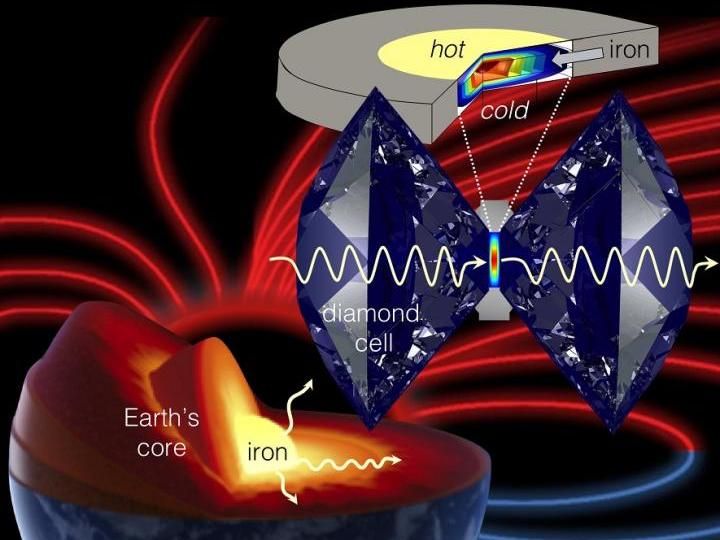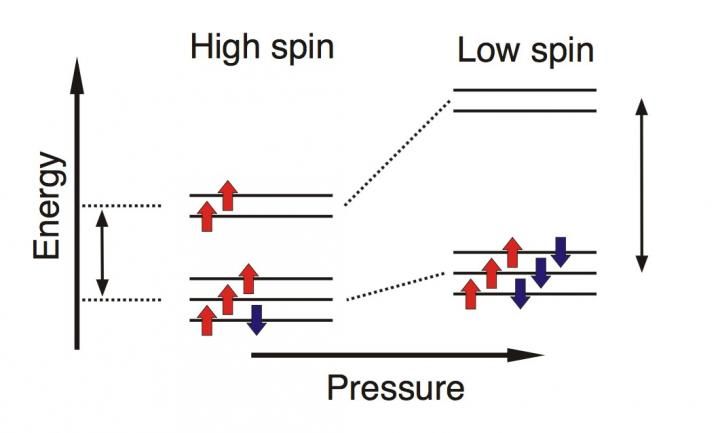Just what sustains Earth's magnetic field anyway?
Earth's magnetic field shields us from deadly cosmic radiation, and without it, life as we know it could not exist here. The motion of liquid iron in the planet's outer core, a phenomenon called a "geodynamo," generates the field. But how it was first created and then sustained throughout Earth's history has remained a mystery to scientists. New work from a team led by Carnegie's Alexander Goncharov sheds light on the history of this incredibly important geologic occurrence.

This is an illustration of how the diamond anvil cell is used to mimic and study planetary core conditions.
Courtesy of Stewart McWilliams
Our planet accreted from rocky material that surrounded our Sun in its youth, and over time the most-dense stuff, iron, sank inward, creating the layers that we know exist today--core, mantle, and crust. Currently, the inner core is solid iron, with some other materials that were dragged along down during this layering process. The outer core is a liquid iron alloy, and its motion gives rise to the magnetic field.
A better understanding of how heat is conducted by the solid of the inner core and the liquid in the outer core is needed to piece together the processes by which our planet, and our magnetic field, evolved--and, even more importantly, the energy that sustains a continuous magnetic field. But these materials obviously exist under very extreme conditions, both very high temperatures and very intense pressures. This means that their behavior isn't going to be the same as it is on the surface.
"We sensed a pressing need for direct thermal conductivity measurements of core materials under conditions relevant to the core," Goncharov said. "Because, of course, it is impossible for us to reach anywhere close to Earth's core and take samples for ourselves."
The team used a tool called a laser-heated diamond anvil cell to mimic planetary core conditions and study how iron conducts heat under them. The diamond anvil cell squeezes tiny samples of material in between two diamonds, creating the extreme pressures of the deep Earth in the lab. The laser heats the materials to the necessary core temperatures.
Using this kind of lab-based mimicry, the team was able to look at samples of iron across temperatures and pressures that would be found inside planets ranging in size from Mercury to Earth--345,000 to 1.3 million times normal atmospheric pressure and 2,400 to 4,900 degrees Fahrenheit--and study how they propagate heat.
They found that the ability of these iron samples to transmit heat matched with the lower end of previous estimates of thermal conductivity in Earth's core--between 18 and 44 watts per meter per kelvin, in the units scientists use to measure such things. This translates to predictions that the energy necessary to sustain the geodynamo has been available since very early in the history of Earth.
"In order to better understand core heat conductivity, we will next need to tackle how the non-iron materials that went along for the ride when iron sunk to the core affect these thermal processes inside of our planet," Goncharov added.
Original publication
Other news from the department science

Get the chemical industry in your inbox
By submitting this form you agree that LUMITOS AG will send you the newsletter(s) selected above by email. Your data will not be passed on to third parties. Your data will be stored and processed in accordance with our data protection regulations. LUMITOS may contact you by email for the purpose of advertising or market and opinion surveys. You can revoke your consent at any time without giving reasons to LUMITOS AG, Ernst-Augustin-Str. 2, 12489 Berlin, Germany or by e-mail at revoke@lumitos.com with effect for the future. In addition, each email contains a link to unsubscribe from the corresponding newsletter.




























































